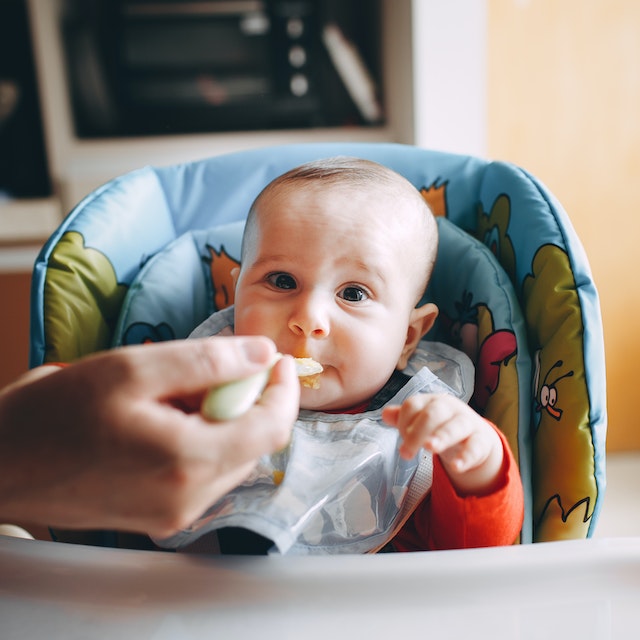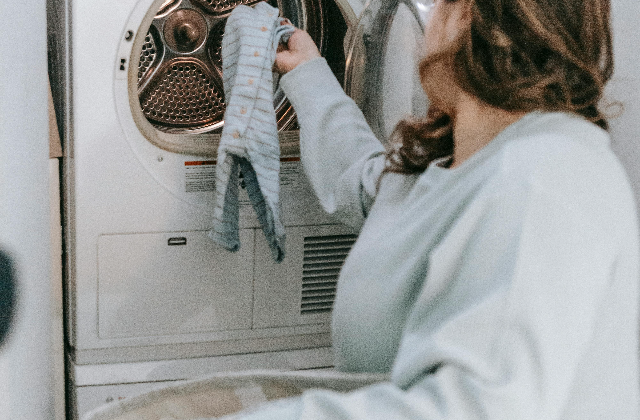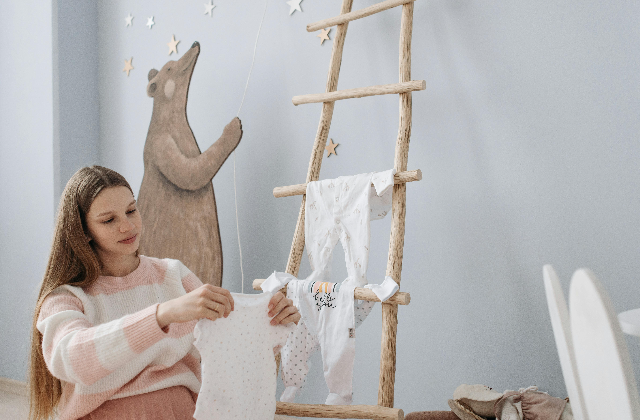
Bibs are vital in keeping a baby’s clothes clean and protected from stains caused by food, milk, drool, and spit-up. They are a practical solution to minimize the time spent on frequent clothing changes and laundry due to the messiness of caring for a baby.
A well-designed bib is a reliable shield, catching and containing the various substances that can soil a baby’s clothes. Whether it’s the remnants of a messy meal, dribbles of milk, excessive drool during teething, or unexpected spit-up, the bib acts as a barrier, preventing these substances from reaching and staining the baby’s clothing.
Furthermore, beyond their functional benefits, bibs are essential for maintaining the health and safety of your baby. By using a bib, you can prevent potential skin irritations or rashes caused by prolonged exposure to moisture or acidic substances. Bibs provide a comfortable and protective layer between your baby’s delicate skin and any accidental spills or messes.
When selecting a bib for your baby, it is important to choose one that is designed with safety in mind and also think about what does a baby bib catch. Look for bibs made of safe and non-toxic materials, free from any potential choking hazards or loose parts. Ensure the bib fits properly and comfortably around your baby’s neck, allowing for easy movement and breathability.
By incorporating the use of bibs into your baby’s daily routine, you not only save time and effort in cleaning and changing clothes but also prioritize the health and comfort of your little one. So, embrace the practicality and convenience of bibs, making mealtime and everyday activities enjoyable for both you and your baby while keeping their clothes clean and protected.
What Does A Baby Bib Catch And Do Bibs Come In Different Kinds?

You can find bibs in different colors, sizes, and styles to catch all kinds of baby drool, and here are a few types of bibs you should consider adding to your collection.
1. Bibs For Newborns And Babies
Even babies who are not yet eating solids or sprouting pearly whites could use some extra protection. When your baby feeds, a bib can keep dribbled milk or formula off his or her clothes — and it’ll help soak up the inevitable spit up. You’ll probably need many of these each day, so get a lot.
2. Breastfeeding Bib
Breastfeeding mothers and bottle-feeding mothers wear these to keep milk from reaching their sleeves and avoid the stains and smells that come from spilled milk on clothing.
3. Drool Or Teething Bib
It is common for babies to drool, and the saliva soon drains off their clothes, causing them to get wet. This can be especially true if they start teething, where it gets worse. A drool bib, which needs to be highly absorbent, can keep them dry when they are drooling.
4. Bandana Bib
A bandana bib is a stylish, functional, and beautiful bib worn to catch baby drool or as a fashion item. They are designed to catch baby teething drools, prevent drool rash, and keep them dry. The biggest advantage is that they snap, so the baby cannot pull them off.
5. Feeding Bib
Most of these bibs are made of food-grade silicone materials. These are easy to clean by wiping with a soft cloth. They also come with a pocket to catch all of the food particles and spills that may occur during the introduction of solid food.
6. Long-sleeved Bibs (Smock Bibs)
It is a great set of bibs for baby-led weaning and toddlers. They cover their sleeves and feature pockets to catch all of the spills from the soup. It will keep their clothes free of stains and save you lots of money on laundry detergent.
7. Disposable Bibs
For traveling, disposable bibs are great since you can only use them once and then throw them away.
8. Bibs for teething or drooling
A lightweight bib will absorb spit and keep her shirt from getting soaked (and potentially irritating her skin underneath). Some babies and toddlers drool a great deal, while others only drool when teething. Buying cloth bibs in bulk is a good idea for a drooly tot who goes through several bibs a day.
Tips On How To Select A Good Bib
Depending on your baby’s age and activity, there are certain qualities a good bib should possess. The bib should have multiple layers and be made from an absorbent material, such as cotton or bamboo.
A bib with pleats to absorb excess drool, as well as one that adjusts as your baby grows, is essential.
Material
When you are shopping for baby bibs, you will notice that a large number of them are available in cloth-like fabrics as well as silicone material. It’s up to you which material you think would be the most suitable for your little one.
Both materials have their advantages and disadvantages, so whatever you choose you cannot go wrong.
In most cases, cloth bibs can be thrown into the washing machine once they have been used. Having silicone bibs makes it easy to clean since you don’t have to worry about wiping it off when you’re done using them.
Once you’ve finished feeding, silicone bibs can be washed in the sink with some soap and water. If your child has sensitive skin, you’ll also need to think about material, since some silicone products might irritate the skin when worn for too long.
Size
Oftentimes, parents and caregivers are unaware that baby bibs come in a variety of sizes that are appropriate for kids of different ages. Toddler bibs, for instance, are larger than infant bibs and usually come with a food catcher system.
Newborn bibs may be a great option for you if you have a little baby or a newborn. These are much smaller than your standard bib. They are ideal for catching any milk or spit-up that may fall during feeding times.
In general, you just want a bib that is large enough to cover your baby should he or she make any messes (and there will be!).
Features
In addition to standard bibs being excellent for catching small amounts of liquid, a more modern bib may also have other features, such as adjustable snaps or food catchers, which are essential features for some families, while others may be perfectly happy with just a basic bib.
Furthermore
It is good to use food catchers once children are eating solid food more regularly. Food that does not make it into their mouths is caught by the food catchers, so it doesn’t end up on the floor, while the baby can still eat it, so it does not go to waste.
Some bibs have adjustable snaps instead of Velcro so that you can adjust them as your child grows. They also act as an extra deterrent to keep your child from attempting to remove their bib when they are eating so you can ensure this never happens.
Types Of Baby Bibs
1. Bibs made of silicone
There are many silicone bibs on the market today that are soft, flexible, and waterproof. They can also be wiped clean after a mealtime and many of them have a lip or pocket on the bottom to catch the food that your baby drops so that it does not end up on her lap.
2. Plastic Bibs
The plastic bib is thin like a cloth bib, but it is made from waterproof plastic that can be wiped clean. Some plastic bibs have pockets that catch crumbs, but they don’t always catch as much as silicone bibs. Some options are also big enough to cover a child’s shoulders or lap.
3. Bibs with a smock-style design
With smock-style bibs, you can choose from a variety of waterproof, wipe-clean bibs that come with sleeves. Since they offer full coverage, they are a good option for messy eaters.
4. Disposable bibs
If you are traveling or taking out meals at a restaurant, disposable bibs can be very useful as they are one-use products.
5. Cloth Bibs
A cloth bib is simple, machine-washable, and it is made from a material that is soft and absorbent like cotton, muslin, or terry cloth.

6. Bandana Bibs
These bandana bibs work just like regular cloth bibs but with a little more style. They are appropriate for any age group.
However, they make a good choice for toddlers with droopy heads because the bandana style makes them seem less babyish while still being functional.
7. Newborn Bibs
The newborn bib is a cloth bib that is extra small, and designed to fit the tiny neck of your baby.
8. Multi-use Bibs
Multi-use bibs are burp cloths with a contoured shape that can be draped over your baby’s shoulders. These can be used as bibs in addition to being burp cloths.
Perfect Bibs For Newborn
If you are expecting a baby, you will probably need a basic fabric bib to soak up their drool, spit-up, milk, or formula dribbles.
Since your baby is unlikely to start eating baby food, until they are between four and six months old; choose an adjustable bib that has soft, non-irritating material. Newborns grow rapidly, so find a bib that is soft, and non-irritating.
Best Bibs By Age Group
Quality baby bibs are used for months, even years a times. But some are best suited to certain situations.
Since most babies don’t begin eating baby food until about six months. Regular bibs and drool bibs are the most useful in such cases.
A feeding bib can be used for as long as you wish. You should start buying them once your child reaches four to six months. You can combine them with droolers. So that your child’s clothes are protected – no matter what activity they are engaged in.
Smock bibs aren’t practical for newborns. But you may find a purpose for them as they grow older and start eating fruits and vegetables.
Can A Newborn Baby Wear A Bib
When a newborn is feeding, he or she may spit up frequently. This bib will help protect your adorable new baby clothes from getting spit up. You should use bibs from the moment you bring your new baby home. But as they grow up, you may want to switch from simple bibs to larger ones. Especially those with food-catching pockets.
If used correctly, bibs are not only fun and practical but they are also super comfortable. They are also safe for your baby.
Is It Ok For Babies To Sleep With Bibs On?
You ought to remove the bib while your baby is sleeping to ensure their safety. You should also never leave your baby unattended while they are wearing a bib if they are awake.
All bibs are made from cotton and soft fabrics. It is important to wash them after each use at a 30-degree temperature. Tumble-dry them on low heat to maintain the bibs’ hygienic condition.
Bottom Line
Baby bibs are an essential item for newborns, typically introduced when they are around 1-2 weeks old, or even earlier for bottle-fed babies. They serve a crucial purpose, especially for breastfeeding infants, by keeping them dry in case of spit-ups or dribbles.
However, it’s important to be aware of the potential risk of suffocation associated with using bibs for newborns. Caution must be exercised to ensure the safety of your baby. It is crucial to never let your baby sleep with a bib on, as it poses a suffocation hazard. Additionally, it’s essential to closely monitor your baby while they are wearing a bib to prevent it from covering their face.
When selecting baby bibs, the choice of material is a key consideration. Opt for materials that are easy to wipe clean or can be machine washed for convenient maintenance.
Size is another important factor to consider when choosing a bib. Ensure that it appropriately fits your baby’s neck and provides adequate coverage to protect their clothes. Some bibs may offer additional features like extra snaps or food catchers, which can enhance their functionality.
When researching and reviewing different bib options, pay attention to aspects such as design, features, size, material quality, ease of use, ease of cleaning, and overall value for money. This will help you make an informed decision and select the bibs that best meet your needs and preferences.
By prioritizing safety and considering important factors such as material and size, you can confidently choose suitable bibs for your newborn, providing them with comfort and protection during feeding and minimizing messes that require frequent clothing changes.
Leave a Reply
You must be logged in to post a comment.